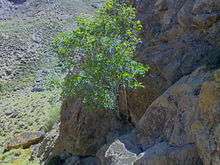Common fig
| Ficus carica – Common fig | |
|---|---|
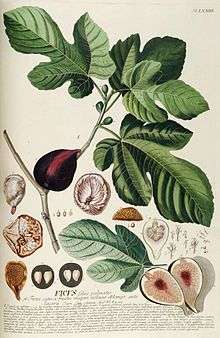 | |
| Foliage and fruit drawn in 1771[1] | |
| Scientific classification | |
| Kingdom: | Plantae |
| (unranked): | Angiosperms |
| (unranked): | Eudicots |
| (unranked): | Rosids |
| Order: | Rosales |
| Family: | Moraceae |
| Tribe: | Ficeae |
| Genus: | Ficus |
| Subgenus: | Ficus |
| Species: | F. carica |
| Binomial name | |
| Ficus carica L. | |
| Synonyms[2] | |
|
Synonymy
| |
Ficus carica is an Asian species of flowering plants in the mulberry family, known as the common fig (or just the fig). It is the source of the fruit also called the fig, and as such is an important crop in those areas where it is grown commercially. Native to the Middle East and western Asia, it has been sought out and cultivated since ancient times, and is now widely grown throughout the world, both for its fruit and as an ornamental plant.[3][4] The species has become naturalized in scattered locations in Asia and North America.[5][6]
Description
Ficus carica is a gynodioecious (functionally dioecious),[7] deciduous tree or large shrub, growing to a height of 7–10 metres (23–33 ft), with smooth white bark. Its fragrant leaves are 12–25 centimetres (4.7–9.8 in) long and 10–18 centimetres (3.9–7.1 in) across, and deeply lobed with three or five lobes. The complex inflorescence consists of a hollow fleshy structure called the syconium, which is lined with numerous unisexual flowers. The flowers themselves are not visible from outside the syconium, as they bloom inside the infructescence. Although commonly referred to as a fruit, the fig is actually the infructescence or scion of the tree, known as a false fruit or multiple fruit, in which the flowers and seeds are borne. It is a hollow-ended stem containing many flowers. The small orifice (ostiole) visible on the middle of the fruit is a narrow passage, which allows the specialized fig wasp Blastophaga psenes to enter the fruit and pollinate the flower, whereafter the fruit grows seeds. See Ficus: Fig fruit and reproduction system.
The edible fruit consists of the mature syconium containing numerous one-seeded fruits (druplets).[7] The fruit is 3–5 centimetres (1.2–2.0 in) long, with a green skin, sometimes ripening towards purple or brown. Ficus carica has milky sap (laticifer). The sap of the fig's green parts is an irritant to human skin.[8]
Habitat
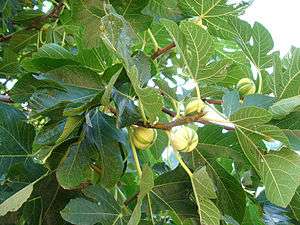
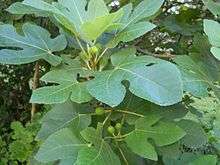
The common fig tree has been cultivated since ancient times and grows wild in dry and sunny areas, with deep and fresh soil; also in rocky areas, from sea level to 1,700 meters. It prefers light and medium soils, requires well-drained soil, and can grow in nutritionally poor soil. Unlike all fig trees, Ficus carica does not require pollination by a wasp or from another tree,[9][10] but can be pollinated by a particular species of wasp (in its case Blastophaga psenes) to produce seeds. The plant can tolerate seasonal drought, and the Middle Eastern and Mediterranean climate is especially suitable for the plant. Situated in a favorable habitat, old specimens when mature can reach a considerable size and form a large dense shade tree. Its aggressive root system precludes its use in many urban areas of cities, but in nature helps the plant to take root in the most inhospitable areas. The common fig tree is mostly a phreatophyte that lives in areas with standing or running water. It grows well in the valleys of the rivers and ravines saving no water, having strong need of water that is extracted from the ground. The deep-rooted plant searches groundwater, in aquifers, ravines, or cracks in the rocks. The fig tree, with the water, cools the environment in hot places, creating a fresh and pleasant habitat for many animals that take shelter in its shade in the times of intense heat.
Ecology
Ficus carica is dispersed by birds and mammals that scatter their seeds in droppings. Fig fruit is an important food source for much of the fauna in some areas, and the tree owes its expansion to those that feed on its fruit. The common fig tree also sprouts from the root and stolon issues.
The infructescence is pollinated by a symbiosis with a kind of fig wasp (Blastophaga psenes). The fertilized female wasp enters the fig through the scion, which is a tiny hole in the crown (the ostiole). She crawls on the inflorescence inside the fig and pollinates some of the female flowers. She lays her eggs inside some of the flowers and dies. After weeks of development in their galls, the male wasps emerge before females through holes they produce by chewing the galls. The male wasps then fertilize the females by depositing semen in the hole in the gall. The males later return to the females and enlarge the holes to enable the females to emerge. Then some males enlarge holes in the scion, which enables females to disperse after collecting pollen from the developed male flowers. Females have a short time (<48 hours) to find another fig tree with receptive scions to spread the pollen, assist the tree in reproduction, and lay their own eggs to start a new cycle.
History
The edible fig is one of the first plants that was cultivated by humans. Nine subfossil figs of a parthenocarpic (and therefore sterile) type dating to about 9400–9200 BC were found in the early Neolithic village Gilgal I (in the Jordan Valley, 13 km north of Jericho). The find predates the domestication of wheat, barley, and legumes, and may thus be the first known instance of agriculture. It is proposed that this sterile but desirable type was planted and cultivated intentionally, one thousand years before the next crops were domesticated (wheat and rye).[11]
Figs were also a common food source for the Romans. Cato the Elder, in his De Agri Cultura, lists several strains of figs grown at the time he wrote his handbook: the Mariscan, African, Herculanean, Saguntine, and the black Tellanian (De agri cultura, ch. 8). The fruits were used, among other things, to fatten geese for the production of a precursor of foie gras.
It was cultivated from Afghanistan to Portugal, also grown in Pithoragarh in the Kumaon hills of India. From the 15th century onwards, it was grown in areas including Northern Europe and the New World.[3] In the 16th century, Cardinal Reginald Pole introduced fig trees to Lambeth Palace in London.
In 1769, Spanish missionaries led by Junipero Serra brought the first figs to California. The Mission variety, which they cultivated, is still popular.[12] The fact that it is parthenocarpic (self-pollinating) made it an ideal cultivar for introduction.
The Kadota cultivar is even older, being mentioned by the Roman naturalist Pliny in the 1st century A.D.[13]
History in California
As California’s population grew, especially after the goldrush, a number of other varieties were brought to California by individuals and nurserymen from the East Coast of the United States and from France and England, and by the end of the 19th century, it became apparent that California had potential for being a great fig-producing state with its Mediterranean climate and a latitude of 38 degrees, lining San Francisco up with Smyrna, Turkey. G. P. Rixford first brought true Smyrna figs to California in 1880. The effort was amplified by the San Francisco Bulletin Company, which sought to bring new varieties from Smyrna to California and distribute the cuttings to the Bulletin’s subscribers, with the expectation that the subscribers would report back which varieties were most fit for California or regions of California. In 1881, some 14,000 cuttings were shipped in good condition to California and distributed to Bulletin Company subscribers as promised. However, not one of the trees planted produced a single mature fruit.[3] George Roeding concluded this was due to the lack of pollination since the insect pollinator was not present in California.[12] After a couple failed attempts, fig wasps were successfully introduced to California on April 6, 1899 to allow for fruit production of Smyrna-type figs.[3]
The most popular variety of Smyrna-type fig is Calimyrna, a name combining “California” and “Smyrna.” The variety itself, however, is not one produced through a breeding program, but it is from one of the cuttings brought to California in the latter part of the 19th century. It is identical to the Lob Injir variety that has been grown in Turkey for many centuries.[13]
Etymology
The term fig has its origins from the Latin word, ficus, as well as the older Hebrew name, feg.[14] The name of the caprifig (Ficus caprificus Risso) is derived from Latin, with capro referring to goat and ficus referring to fig.[15]
Cultivation
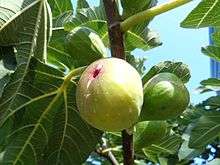
The common fig is grown for its edible fruit throughout the temperate world. It is also grown as an ornamental tree, and the cultivar 'Brown Turkey' has gained the Royal Horticultural Society's Award of Garden Merit.[16]
Figs can be found in continental climates with hot summers as far north as Hungary and Moravia, and can be harvested up to four times per year. Thousands of cultivars, most named, have been developed as human migration brought the fig to many places outside its natural range.
Two crops of figs are potentially produced each year.[17] The first or breba crop develops in the spring on last year's shoot growth. In contrast, the main fig crop develops on the current year's shoot growth and ripens in the late summer or fall. The main crop is generally superior in both quantity and quality to the breba crop. However, some cultivars produce good breba crops (e.g., 'Black Mission', 'Croisic', and 'Ventura').
There are basically three types of edible figs:[18]
- Persistent (or common) figs have all female flowers that do not need pollination for fruiting; the fruit can develop through parthenocarpic means. This is a popular horticulture fig for home gardeners. Dottato (Kadota), Black Mission, Brown Turkey, Brunswick, and Celeste are some representative cultivars.
- Caducous (or Smyrna) figs require cross pollination by the fig wasp with pollen from caprifigs for the fruit to mature. If not pollinated the immature fruits drop. Some cultivars are Smyrne (Lob Incir in Turkey) - (Calimyrna in the Great Central Valley USA), Marabout, Inchàrio, and Zidi.
- Intermediate (or San Pedro) figs set an unpollinated breba crop, but need pollination for the later main crop. Examples are Lampeira, King, and San Pedro.
The fig likes dry sunny sites, the soil dry or drained. Excessive growth has to be limited to promote the fruiting. It thrives in both sandy and rocky soil. As the sun is really important it is better to avoid shades. Some varieties are more adapted to harsh and wet climates.
Propagation
Figs plants are easy to propagate through several methods. Propagation using seeds is not the preferred method since vegetative methods exist that are quicker and more reliable, that is, they do not yield the inedible caprifigs. However, one can plant seeds of dried figs with moist sphagnum moss or other media in a Ziploc bag and expect germination in a few weeks to several months. The tiny plants can be transplanted out little by little once the leaves open, and despite the tiny initial size can grow to 1 foot (30 cm) or more within one year from planting seeds.
Main vegetative propagation, or spring propagation: before the tree starts growth, cut 15–25 cm (6–10 inch) shoots that have healthy buds at their ends, and set into a moist mix of soil and peat-moss located in shade in first time, buried 3/4 of their length. Larger diameter stems are better – intermediate cuttings on branches can be done too (up to diam. 3/4") – but in this case the upper side must be cut inclined, thus marking the upper part, to avoid planting upside-down. Grow one year in a nursery, in a pot or in-ground spaced one foot apart, till winter. Before the plant starts growth, plant it in the desired final location.
For propagation in the mid-summer months, air layer new growth in August (mid-summer) or insert hardened off 15–25 cm (6-10 inches) shoots into moist perlite or a sandy soil mix, keeping the cuttings shaded until new growth begins; then gradually move them into full sun. For spring propagation, before the tree starts growth, cut 15–25 cm (6-10 inches) shoots that have healthy buds at their ends, and set into a moist perlite and/or sandy soil mix located in the shade. Once the cuttings start to produce leaves, bury them up to the bottom leaf to give the plant a good start in the desired location.
An alternative propagation method is bending over a taller branch, scratching the bark to reveal the green inner bark, then pinning the scratched area tightly to the ground. Within a few weeks, roots will develop and the branch can be clipped from the mother plant and transplanted where desired.
Cultivars
There are dozens of fig cultivars, such as those below.[19][20]
- "Abicou"
- Alma
- Australia (Thailand)
- "Brooke Japan"
- "Brooke Red"
- "Bornholms"
- "Bordissot Negra"
- "Brogiotto nero"
- "Brogiotto bianco"
- "Black israel"
- "Brunswick"
- "Black Mission"
- "Black Jack"
- "Black Genoa"
- "Byadi"
- "BTM6"
- "Blue Giant"
- Black Jack (Thailand)
- Brown Turkey
- Celeste
- Conadria (Thailand)
- Dauphine (Thailand)
- Desert King
- Col de dame blanc
- Col de dame gris
- Ealy Violet
- Flanders
- Genao\
- hardy Chicago
- Inca gold (Thailand)
- Italian Brooklyn White (Thailand)
- Italian White
- Italian Black
- Italian Honey
- Japan (BTM6) (Thailand)
- Jurupa
- Kadota (Thailand)
- Kunming (Thailand)
- King
- Larme de Jaune
- Marseilles vs Black
- Negronne
- Orourke
- Osborn Prolific (Thailand)
- Pop's Purple
- Quantico
- Smith
- Sunee2
- Taiwan (TWA5) (Thailand)
- Zöld óriás (Hungary)
- Texas Everbearing
- Violette de Bordeaux
- Wuhan
- Yede Vern
- Zidi
- Kadota: used in fig rolls, dries well
- Marseilles: also known as Blanch
- Mission: black, sweet, commonly dried
- Timla in Kumaon
- Györöki lapos (Hungary)
Breeding
While the fig contains more naturally occurring varieties than any other tree crop, a formal breeding program was not developed until the beginning of the 20th century.[21] Ira Condit, “High Priest of the Fig,” and William Storey tested some thousands of fig seedlings in the early 20th Century based at University of California, Riverside.[20] It was then continued at the University of California, Davis. However, the fig breeding program was ultimately closed in the 1980’s.[21]
Due to insect and fungal disease pressure in both dried and fresh figs, the breeding program was revived in 1989 by James Doyle and Louise Ferguson using the germplasm established at UC Riverside by Ira Condit and William Storey. Crosses were made and two new varieties are now in production in California: the public variety “Sierra,” and the patented variety “Sequoia.” [22]
| Rank | Country | Production (Tonnes) |
|---|---|---|
| 1 | | 274,535 |
| 2 | | 171,062 |
| 3 | | 110,058 |
| 4 | | 102,694 |
| 5 | | 78,000 |
| 6 | | 41,224 |
| 7 | | 35,072 |
| 8 | | 28,010 |
| 9 | | 27,255 |
| 10 | | 25,000 |
| World | 1,031,391 | |
| Source: UN Food & Agriculture Organization [23] | ||
Production
Turkey is the leading producer of figs (274.5 thousand metric tons), having 27% of the world total of over one million metric tons (table). Significant production occurs also in the North African region, particularly Egypt, Algeria and Morocco (table).
While the United States is lower on the list of fig producing countries, California produces ~ 80% of the U.S. production,[24] some of the greatest research on fig breeding and development in the last 100 years has taken place in California under the auspices of the private growers and public employees of the University of California. As of 2012, there are about 16,000 acres of figs grown in California of about 10 varieties. Those varieties in relative order of acreage are: Calimyrna, Mission, Adriatic types (Conadria, Adriatic, Di Redo, Tena), Brown Turkey, Kadota, Sierra, and Sequoia.[25]
Culinary use
Figs can be eaten fresh or dried, and used in jam-making. Most commercial production is in dried or otherwise processed forms, since the ripe fruit does not transport well, and once picked does not keep well. The widely produced fig newton or fig roll is a biscuit (cookie) with a filling made from figs.
Fresh figs are in season from August through to early October. Fresh figs used in cooking should be plump and soft, and without bruising or splits. If they smell sour, the figs have become over-ripe. Slightly under-ripe figs can be kept at room temperature for 1-2 days to ripen before serving. Figs are most flavorful at room temperature.[26]
Nutrition and phytochemicals
Raw figs are a good source (14% of the Daily Value, DV) of dietary fiber per 100 gram serving (74 calories), but otherwise do not supply essential nutrients in significant content (table).
In a 100 gram serving providing 229 calories, dried figs are a rich source (> 20% DV) of dietary fiber and the essential mineral, manganese (26% DV), while several other dietary minerals are in moderate-to-low content.[27]
Figs contain diverse phytochemicals, including polyphenols such as gallic acid, chlorogenic acid, syringic acid, (+)-catechin, (−)-epicatechin and rutin.[28][29] Fig color may vary between cultivars due to various concentrations of anthocyanins, with cyanidin-3-O-rutinoside having particularly high content.[30]
Religious references

In the Biblical Book of Genesis, Adam and Eve clad themselves with fig leaves (Genesis 3:7) after eating the "forbidden fruit" from the Tree of Knowledge of Good and Evil. Likewise, fig leaves, or depictions of fig leaves, have long been used to cover the genitals of nude figures in painting and sculpture. Art collectors and exhibitors often added these depictions long after the original work was completed.
The use of the fig leaf as a protector of modesty or shield of some kind has entered the language.
The Book of Deuteronomy specifies the fig as one of the Seven Species (Deuteronomy 8:7-8), describing the fertility of the land of Canaan. This is a set of seven plants indigenous to the Middle East that together can provide food all year round. The list is organized by date of harvest, with the fig being fourth due to its main crop ripening during summer.
Also in the Bible (Matthew 21:18–22 and Mark 11:12–14, 19–21) is a story of Jesus finding a fig tree when he was hungry; the tree had leaves on it, but no fruit. Jesus then curses the fig tree, which withers.
The biblical quote "each man under his own vine and fig tree" (1 Kings 4:25) has been used to denote peace and prosperity. It was commonly quoted to refer to the life that would be led by settlers in the American West, and was used by Theodor Herzl in his depiction of the future Jewish Homeland: "We are a commonwealth. In form it is new, but in purpose very ancient. Our aim is mentioned in the First Book of Kings: 'Judah and Israel shall dwell securely, each man under his own vine and fig tree, from Dan to Beersheba".[31] United States President George Washington, writing in 1790 to the Touro Synagogue of Newport, Rhode Island, extended the metaphor to denote the equality of all Americans regardless of faith.[32]
Buddha achieved enlightenment under the bodhi tree, a large and old sacred fig tree (Ficus religiosa, or Pipal).
Sura 95 of the Qur'an is named al-Tīn (Arabic for "The Fig"), as it opens with the oath "By the fig and the olive." The fruit is also mentioned elsewhere in the Qur'an. Within the Hadith, Sahih al-Bukhari records Muhammad stating: "If I had to mention a fruit that descended from paradise, I would say this is it because the paradisiacal fruits do not have pits...eat from these fruits for they prevent hemorrhoids, prevent piles and help gout."[33]
In Greek mythology, the god Apollo sends a crow to collect water from a stream for him. The crow sees a fig tree and waits for the figs to ripen, tempted by the fruit. He knows that he is late and that his tardiness will be punished, so he gets a snake from the stream and collects the water. He presents Apollo with the water and uses the snake as an excuse. Apollo sees through the crow's lie and throws the crow, goblet, and snake into the sky where they form the constellations Hydra, Crater, and Corvus.
In Aristophanes' Lysistrata one of the women boasts about the "curriculum" of initiation rites she went through to become an adult woman (Lys. 641–7). As her final accomplishment before marriage, when she was already a fair girl, she bore the basket as a kanephoros, wearing a necklace of dried figs.
In the course of his campaign to persuade the Roman Republic to pursue a third Punic War, Cato the Elder produced before the Senate a handful of fresh figs, said to be from Carthage. This showed its proximity to Rome (and hence the threat), and also accused the Senate of weakness and effeminacy: figs were associated with femininity, owing to the appearance of the inside of the fruit.[34]
The word "sycophant" comes from the Greek word sykophantes, meaning"one who shows the fig". "Showing the fig" was a vulgar gesture made with the hand.[35]
Since the flower is invisible, there are various idioms related to it in languages around the world. In a Bengali idiom as used in tumi yēna ḍumurēr phul hay.ē gēlē (তুমি যেন ডুমুরের ফুল হয়ে গেলে), i.e., 'you have become (invisible like) the fig flower (doomurer phool)'. The derisive English idiom I don't care a fig probably originates from the abundance of this fruit. There is a Hindi idiom related to flower of fig tree, गूलर का फूल (gūlar kā phūl i.e. flower of fig) means something that just would not ever see i.e. rare of the rarest[36] In Awadh region of Uttar Pradesh state of India apart from standard Hindi idiom a variant is also used; in the region it is assumed that if something or work or job contains (or is contaminated by) flower of fig it will not get finished e.g. this work contains fig flower i.e. it is not getting completed by any means.
Gular ka phool (flower of fig) is a collection of poetry in written in Hindi by Rajiv Kumar Trigarti.[37]
There is also a poem in Telugu written by Yogi Vemana, which says "Medi pandu chuda melimayyi undunu, potta vippi chuda purugulundunu", It means—"The fig fruit looks harmless but once you open you find tiny insects [refers to the fig wasp] in there". The phrase is synonymous to an English phrase—"Don't judge a book by its cover".
Mountain fig
Mountain fig or rock fig (called "Anjeer Kohi", انجیر کوهی, in Persian) is a wild fig, naturally growing in the semi-arid rocky mountainous regions of Iran, especially in the Kohestan Mountains of Khorasan. [8]
The only difference between the mountain fig and other figs is its tolerance of dry and cold climates. It usually does not need any irrigation and is able to survive extremely dry weather and temperatures of −40 °C (−40 °F). The most productive and the oldest mountain fig trees are located in the Zibad mountains.
Gallery
| Leaf & fruit | Fruit | Religious art | Cross-section |
|---|---|---|---|
|
|
|
|
|
|
Leaves and green fruit on common fig tree |
Common fig fruit |
The Expulsion from the Garden of Eden — fresco depicting a distressed Adam and Eve, with and without fig leaves, by Tommaso Masaccio, 1426–27 |
Cutaway-section displaying the fruit anatomy |
See also
- Ficus racemosa ("Cluster fig"), a fig species native to Australia, Malesia, South-East Asia, and the Indian subcontinent
- Ficus sycomorus ("Sycamore fig"), a fig species native to Africa and Lebanon
- Fig cake
- Fig Monday
- Grocer's itch
Footnotes
- ↑ 1771 illustration from Trew, C.J., Plantae selectae quarum imagines ad exemplaria naturalia Londini, in hortis curiosorum nutrit, vol. 8: t. 73 (1771), drawing by G.D. Ehret
- ↑ "The Plant List".
- 1 2 3 4 The Fig: its History, Culture, and Curing, Gustavus A. Eisen, Washington, Govt. print. off., 1901
- ↑ RHS A-Z encyclopedia of garden plants. United Kingdom: Dorling Kindersley. 2008. p. 1136. ISBN 1405332964.
- ↑ Flora of China Ficus carica Linnaeus, 1753. 无花果 wu hua guo
- ↑ Biota of North America Program 2014 county distribution map
- 1 2 Wayne's Word: Sex Determination & Life Cycle in Ficus carica
- 1 2 "Fig, Ficus carica". Purdue University: Horticulture & Landscape Architecture. Retrieved December 6, 2014.
- ↑ Shannon Wolfe, Carnivorous Figs: The Relationship Between Wasps and Figs. UC Master Gardener Program of Contra Costa County, August 27, 2014.
- ↑ Louise Ferguson and Carlos H. Crisosto, The Fig: Overview of an Ancient Fruit. HortScience August 2007 vol. 42 no. 5 1083-1087
- ↑ Kislev et al. (2006a, b), Lev-Yadun et al. (2006)
- 1 2 Roeding, George C. (1903) The Smyrna Fig: At Home and Abroad; published by the author, Fresno, CA, USA
- 1 2 Storey, W.B, Enderud, J.E., Saleeb, W.F., & Mauer, E.M. (1977) The Fig, Ficus carica Linnaeus: Its Biology, History, Culture, and Utilization, Vol. 13 #2,3,4; Jurupa Mountains Cultural Center, Riverside, CA, USA
- ↑ Eisen, Gustav (1901) The Fig: Its History, Culture, and Curing, U.S. Dept. of Ag., Bulletin No. 9, Government Printing Office, Washington, USA
- ↑ Condit, Ira J. (1947) The Fig; Chronica Botanica Co, Waltham, MA, USA
- ↑ "RHS Plant Selector - Ficus carica 'Brown Turkey'". Retrieved 20 June 2013.
- ↑ California Rare Fruit Growers: Fig
- ↑ North American Fruit Explorers: Figs.
- ↑ "Fig Fruit Facts". www.crfg.org. California Rare Fruit Growers. 1996. Retrieved 2016-02-01.
- 1 2 Janick, Jules & Moore, James (editors) (1975) Advances in Fruit Breeding; pgs 568-588: Figs, by Storey, W.B.; Purdue University Press, West Lafayette, IN, USA
- 1 2 Van Deynze, Allen (editor) (2008) 100 years of breeding: UC Davis Plant Breeding Program. Published by the Dean’s Office, Department of Plant Sciences, & Seed Biotechnology Center, Davis, CA, USA
- ↑ "New fig cultivar comparison report released by UC Kearney REC". westernfarmpress.com. Retrieved 2016-02-01.
- ↑ "Production of figs by countries". UN Food & Agriculture Organization. 2011. Retrieved 2013-08-23.
- ↑ McMahon, M.J., Kofranek, A.M., & Rubatzky, V.E. (2002) Hartmann’s Plant Science: Growth, Development, and Utilization of Cultivated Plants, 3rd ed.; Prentice Hall, Upper Saddle River, NJ, USA
- ↑ Doyle, et al (2006) USPTO Patent Full-Text and Image Database, Fig Tree Named ‘Sequoia.’
- ↑ "Fig". BBC Good Food. Retrieved 2016-02-02.
- ↑ "Nutrition facts for dried figs, uncooked per 100 g". Conde Nast for the USDA National Nutrient Database, version SR-21. 2014. Retrieved 5 June 2014.
- ↑ Vinson (1999)
- ↑ Veberic R, Colaric M, Stampar F (2008). "Phenolic acids and flavonoids of fig fruit (Ficus carica L.) in the northern Mediterranean region". Food Chemistry. 106 (1): 153–157. doi:10.1016/j.foodchem.2007.05.061.
- ↑ Solomon A, Golubowicz S, Yablowicz Z, Grossman S, Bergman M, Gottlieb HE, Altman A, Kerem Z and Flaishman MA (2006). "Antioxidant activities and anthocyanin content of fresh fruits of common fig (Ficus carica L.)". J Agric Food Chem. 54 (20): 7717–7723. doi:10.1021/jf060497h. PMID 17002444.
- ↑ Old New Land by Theodor Herzl Old New Land
- ↑ http://www.tourosynagogue.org/index.php/history-learning/gw-letter
- ↑ "Foods of the prophet". IslamOnline.
- ↑ "BBC iPlayer - In our time: the destruction of Carthage". Retrieved 20 June 2013.
- ↑ Online Etymology Dictionary
- ↑ बालुरघाट में दिखा गूलर का विस्मयकारी फूल, Sep 20, 11:39 pm (Hindi version), (Translated version)
- ↑ Gular ka phool by Rajiv Kumar Trigarti
References
- Kislev, Mordechai E.; Hartmann, Anat & Bar-Yosef, Ofer (2006a): Early Domesticated Fig in the Jordan Valley. Science 312(5778): 1372. doi:10.1126/science.1125910 PMID 16741119 (HTML abstract) Supporting Online Material.
- Kislev, Mordechai E.; Hartmann, Anat & Bar-Yosef, Ofer (2006b): Response to Comment on "Early Domesticated Fig in the Jordan Valley". Science 314(5806): 1683b. doi:10.1126/science.1133748 PDF fulltext.
- Lev-Yadun, Simcha; Ne'eman, Gidi; Abbo, Shahal & Flaishman, Moshe A. (2006): Comment on "Early Domesticated Fig in the Jordan Valley". Science 314(5806): 1683a. doi:10.1126/science.1132636 PDF fulltext.
- Vinson, Joe A. (1999): Functional food properties of figs. Cereal Foods World 44(2): 82-87. PDF fulltext
- Vinson, Joe A.; Zubik, Ligia; Bose, Pratima; Samman, Najwa & Proch, John (2005): Dried fruits: excellent in vitro and in vivo antioxidants. J. Am. Coll. Nutr. 24(1): 44–50. PMID 15670984 PDF fulltext.
External links
| Wikimedia Commons has media related to Ficus carica. |
| Wikisource has the text of the 1911 Encyclopædia Britannica article Fig. |

